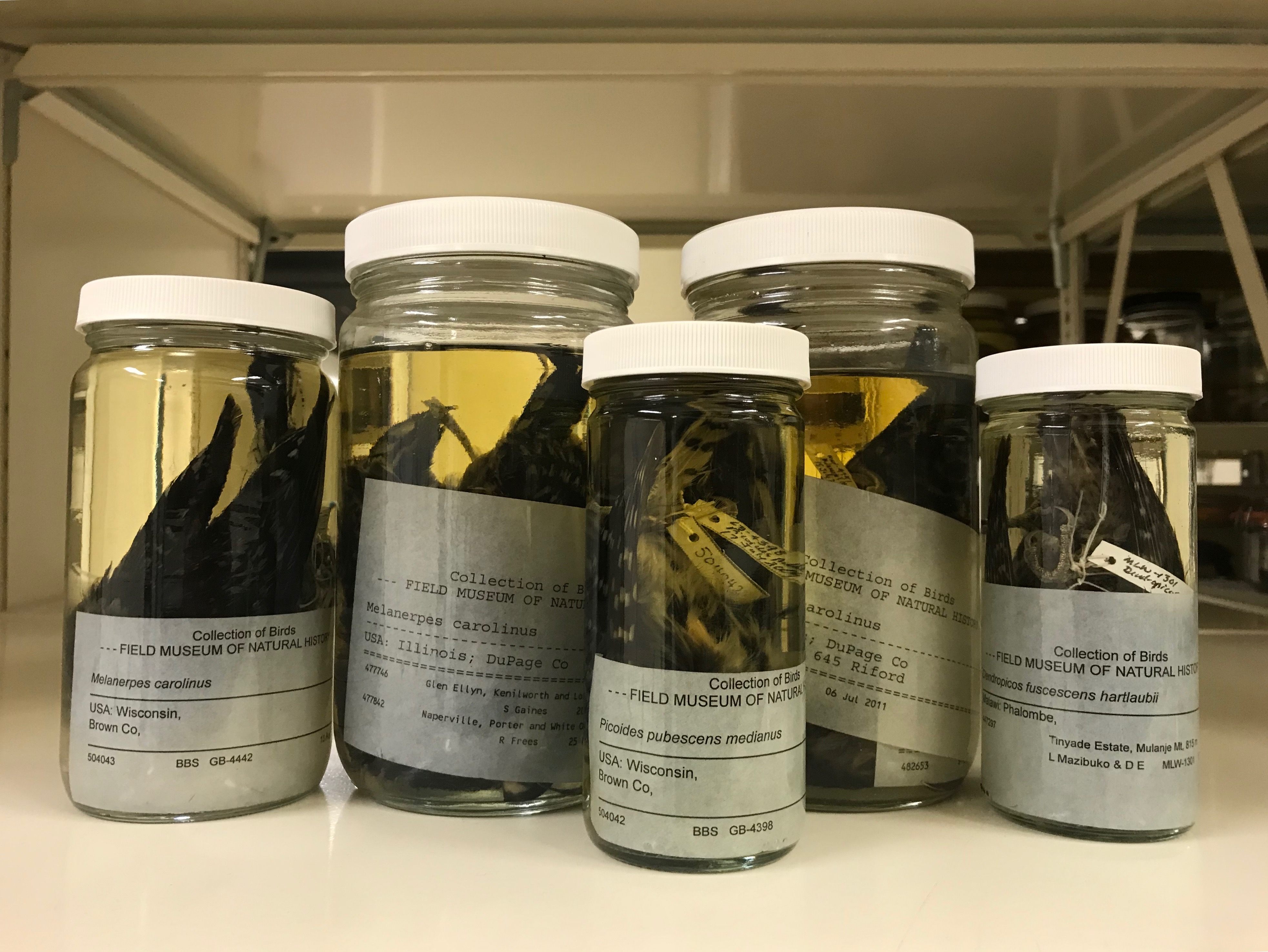What’s Going on Inside Woodpeckers’ Brains?
Researchers pried open the skulls of birds in museum collections to take a closer look.

The downy woodpecker drums in a series of rapid-fire staccatos. It’s not unlike a whirring drill bit that just happens to be feathered and perched on a branch. The featherweight bird—North America’s slightest woodpecker, measuring less than seven inches and weighing less than one ounce—rams against unyielding surfaces over and over, colliding at a force of more than 1,400 g’s. Scientists have long been fascinated by how it appears to avoid splitting headaches or debilitating brain damage.
In the past, researchers have annotated woodpeckers’ frenzied nods with stop-motion cameras and by scanning bones. Various species of woodpeckers have deep arsenals of adaptations. A woodpecker’s brain—about the size of an unshelled walnut—sits snugly against its skull, with little fluid to slosh around in. The shallow pool minimizes jarring. Then there’s the beak: Some species have an upper beak slightly longer than the lower portion, which allows the halves to strike a target at different times, diffusing the force of impact. The bird’s skull is also a bony shock absorber, with layers of compact bone sandwiched between spongier swaths.
The upshot of this work has been, essentially, that woodpeckers must be doing pretty well for themselves. After all, the oldest woodpecker fossil reaches back roughly 25 million years. If all of that pounding was doing a number on them, surely they would have curtailed the behavior by now, right?
“That’s been the assumption,” says Peter Cummings, a neuropathologist at Boston University School of Medicine. “But nobody has never looked at a woodpecker brain.”
When George Farah, then one of Cummings’s graduate students, took a jog through this existing literature, he found that it tended to survey the scenario from the vantage point of genetics, biomechanics, or evolution—no one had gone the histology route. In order to figure out exactly what was going on in there—and what damage that pounding might have left behind—he needed to get beneath the skull and into the tissue.
Unsurprisingly, a wellspring of bird brains is hard to come by. “You can’t go out in the backyard, sit in your lawn chair, and wait with a BB gun,” Cummings says. The researchers asked state game officials in Massachusetts to give them a heads-up if they encountered woodpeckers, but that wasn’t guaranteed—who knew when those might turn up? A state ornithologist suggested natural history museums, which took Farah by surprise—he’d imagined those as being full of taxidermied bodies or articulated skeletons, but hadn’t thought about wet specimens. “Science sometimes has to be like MacGyver: a little bit of duct tape and chewing gum, and you hope for the best,” Cummings says.

Farah started cold-calling museums, and half of the ones he courted gave him the green light. Harvard’s Museum of Natural History and The Field Museum, in Chicago, offered specimens from their collections, all pickled in alcohol. Farah performed craniotomies, slicing a circular flap (“kind of like a monk’s haircut”) and then chipping away at the bony plate. From these brains—which Cummings describes as possessing “the consistency of not-quite-set jello”—Farah excised samples that were 15 and 25 microns wide, roughly one-fifth the thickness of a sheet of paper. Cummings and Farah published their findings in a new study, out today in the journal PLOS One.
Anatomically, there are a slew of differences between woodpecker brains and human noggins: These birds don’t have a cortex, for instance, or the characteristic peaks and valleys (the gyri and sulci) that make our brains look like grooved mazes. But in order to gauge whether birds were sustaining potential brain damage from their high-intensity pecking, the researchers used a series of stains and antibodies to test for tau, a protein that’s also associated with brain disease in humans.
The researchers compared the woodpecker brains against slices from red-wing blackbirds, which don’t exhibit pecking behaviors. (As a control to confirm that the dyes were working correctly, each test also included a sliver of a human brain donated by someone who had Alzheimer’s disease, which is also associated with the presence of tau.)

First, they used a silver stain, which highlights broad patterns of damage—Farah likens it to bathing clothes in a dye. “The idea was, if we don’t see anything, we’re going to forget it,” Cummings says. “If we do see something, then we’ll move on to the histochemical study.” Since they did find accumulations in eight of the 10 woodpecker brains—and none in the control birds—they moved on to a second analysis, which used targeted antibodies specific to tau. The researchers were only able to perform this second analysis on three of the woodpecker samples—the others degraded in the process. Two of those three woodpecker brains showed evidence of tau, while none of the control birds’ did.
That’s not to say that tau is definitely the product of pecking-induced trauma. Tau doesn’t necessarily flag a pathology: In humans, it sometimes accumulates with age, for instance, and some individuals’ brains just have more of it. But it’s one indication that something might not be right. Cummings doesn’t think that the damage in woodpeckers’ brains is a product of age—one of the samples was from a juvenile bird and it, too, showed signs of trauma. But there are various types (or isoforms) of tau, and some of these are even neuroprotective, Cummings says. “Maybe this tau we’re seeing in the woodpeckers might be another protective adaptation to withstand the forces of pecking.” Cummings thinks that future work could get more granular.
One drawback, which the researchers readily acknowledge, is that experiment was small—just 10 woodpeckers. The design would have been stronger, Farah says, if they had separated living woodpeckers into experimental and control groups, allowing one cohort to peck and preventing the other from doing so. Farah hopes that it lays the groundwork for more research. Ann McKee, a neuropathologist at Boston University School of Medicine who studies traumatic brain injuries in humans and was not involved with this research, told the Washington Post that this work is “an important and provocative finding.”
Meanwhile, woodpecker brains, and their supposed protections, continue to inspire the designs of helmets, collars, and other plastic armor for human athletes—even as many questions linger about just what’s happening inside those little avian versions.


































Follow us on Twitter to get the latest on the world's hidden wonders.
Like us on Facebook to get the latest on the world's hidden wonders.
Follow us on Twitter Like us on Facebook